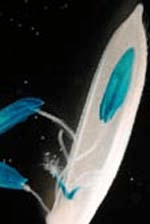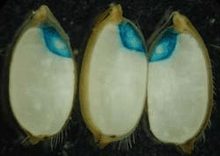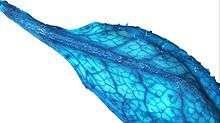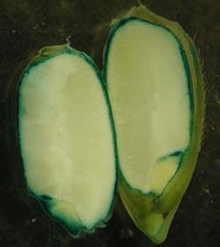GUS reporter system

The GUS reporter system (GUS: β-glucuronidase) is a reporter gene system, particularly useful in plant molecular biology[1] and microbiology.[2] Several kinds of GUS reporter gene assay are available, depending on the substrate used. The term GUS staining refers to the most common of these, a histochemical technique.
Purpose
The purpose of this technique is to analyze the activity of a promoter (in terms of expression of a gene under that promoter) either in a quantitative way or through visualization of its activity in different tissues. The technique is based on β-glucuronidase, an enzyme from the bacterium Escherichia coli;[3] this enzyme, when incubated with some specific colorless or non-fluorescent substrates, can transform them into coloured or fluorescent products.[4]
Substrates
There are different possible glucuronides that can be used as substrates for the β-glucuronidase, depending on the type of detection needed (histochemical, spectrophotometrical, fluorimetrical). The most common substrate for GUS histochemical staining is 5-bromo-4-chloro-3-indolyl glucuronide (X-Gluc): the product of the reaction is in this case a clear blue color. Other common substrates are p-nitrophenyl β-D-glucuronide for the spectrophotometric assay and 4-methylumbelliferyl-beta-D-glucuronide (MUG) for the fluorimetrical assay.[5]
History
The system was originally developed by Richard Anthony Jefferson during his Ph.D. at the University of Colorado at Boulder.[6] He adapted the technique for the use with plants as he worked in the Plant Breeding Institute of Cambridge, between 1985 and 1987.[1] Since then thousands of labs have used the system, making it one of the most widely used tools in plant molecular biology, as underlined by over 6000 citations in scientific literature.[6]
Target organisms

An organism is suitable for a GUS assay if it has no β-glucuronidase or if the activity is very low (background activity). For this reason the assay is not useful in most vertebrates and many molluscs.[5] Since there is no detectable GUS activity in higher plants, mosses, algae, ferns, fungi and most bacteria,[5] the assay is perfectly suited for these organisms.

Thus it is used widely in plant science.
Other reporter systems
The GUS system is not the only available gene reporter system for the analysis of promoter activity. Other competing systems are based on e.g. luciferase, GFP, beta-galactosidase, chloramphenicol acetyltransferase (CAT), alkaline phosphatase. The use of one or the other system is mainly dependent on the organism of interest.
Other uses

The GUS assay, as well as other reporter gene systems, can be used for other kinds of studies other than the classical promoter activity assay. Reporter systems have been used for the determination of the efficiency of gene delivery systems, the intracellular localization of a gene product, the detection of protein-protein or protein-DNA interactions, the efficiency of translation initiation signals and the success of molecular cloning efforts.
Sources
- 1 2 Jefferson, R. A.; Kavanagh, T. A.; Bevan, M. W. (1987). "GUS fusions: Beta-glucuronidase as a sensitive and versatile gene fusion marker in higher plants". The EMBO Journal. 6 (13): 3901–7. PMC 553867
 . PMID 3327686.
. PMID 3327686. - ↑ Vande Broek, A; Lambrecht, M; Vanderleyden, J (1998). "Bacterial chemotactic motility is important for the initiation of wheat root colonization by Azospirillum brasilense". Microbiology (Reading, England). 144 (9): 2599–606. PMID 9782509. doi:10.1099/00221287-144-9-2599.
- ↑ Blanco, C; Ritzenthaler, P; Mata-Gilsinger, M (1982). "Cloning and endonuclease restriction analysis of uidA and uidR genes in Escherichia coli K-12: Determination of transcription direction for the uidA gene". Journal of Bacteriology. 149 (2): 587–94. PMC 216546
 . PMID 6276362.
. PMID 6276362. - ↑ Jefferson, R. A.; Burgess, S. M.; Hirsh, D (1986). "Beta-Glucuronidase from Escherichia coli as a gene-fusion marker". Proceedings of the National Academy of Sciences of the United States of America. 83 (22): 8447–51. PMC 386947
 . PMID 3534890. doi:10.1073/pnas.83.22.8447.
. PMID 3534890. doi:10.1073/pnas.83.22.8447. - 1 2 3 U.S. Patent 5,268,463
- 1 2 Cambia Organization Website: biography of Richard A. Jefferson